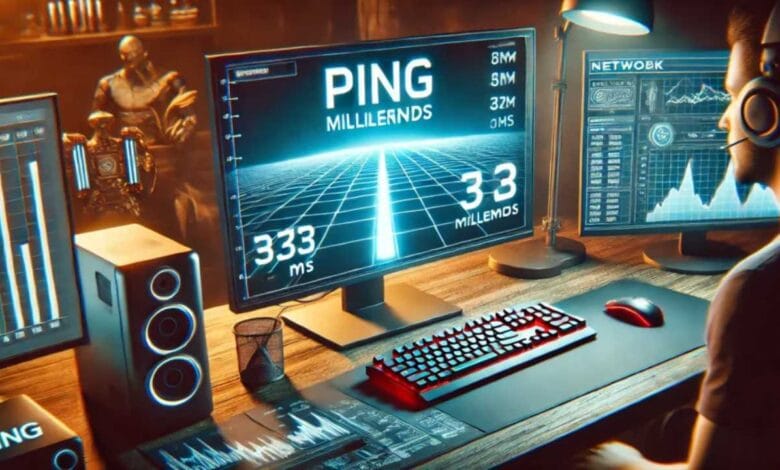What Is Ping in Gaming and How It Affects Online Performance

Everything happens quickly when playing games online, and if your connection is slow, the experience can quickly turn from exciting to annoying. Even if you have the best gaming PC, the best GPU, and the best refresh rate monitor, it won’t matter much if your ping is high. What is ping in gaming, and why is it so important?
What Ping Means in the World of Online Gaming

Ping, to put it simply, is the time it takes for your device to signal a server and get a response. Milliseconds (ms) are used to measure it. A lower ping causes less delay, which speeds up in-game responses. Poor online performance, noticeable lag, and delayed actions are the results of a higher ping.
Look at this table to see how ping stacks up against other internet-related gaming factors:
| Term | Definition | Impact on Gaming |
| Ping (Latency) | Duration of data transmission to and from a server | Directly affects game responsiveness |
| Download Speed | How fast data is received from the server | Affects loading, updates, and streaming |
| Upload Speed | How fast data is sent to the server | Important for streaming or multiplayer |
| Packet Loss | When data packets fail to reach their destination | Causes stutter, freezes, or disconnection |
| Jitter | Variance in ping over time | Leads to inconsistent game performance |
Perhaps the most important element in competitive online gaming is ping. It could mean the difference between losing a close 1v1 or giving up in a fit of rage after being killed before you’ve even seen your opponent.
How Ping Affects Your Online Performance During Gameplay
What is the real effect of ping on your in-game activities, then? Consider yourself in a first-person shooter game. When you spot an enemy, you click to fire. Your action is recorded on the game server almost immediately if your ping is low (for example, 20 ms). Your shot is delayed if your ping is high (150 ms, for example), and your opponent may have moved or even shot you before it registers.
The same holds true for various genres:
- Due to delayed movement, battle royale games (like Warzone or PUBG) have awkward combat and looting.
- Delays in abilities can seriously disrupt timing in MOBA games, such as League of Legends or Dota 2.
- Every frame matters in fighting games, such as Street Fighter, and a high ping is a nightmare.
Even if you’re hitting the right buttons, your opponent always wins if your signal doesn’t get to the server quickly enough.
What Is Considered Good or Bad Ping in Gaming?
Let’s dissect it:
- 0–30 ms: Excellent: easy and real-time responsiveness
- 31–60 ms: Good–Minor lag, usually indiscernible
- 61–100 ms: Playable: There is a noticeable delay of 101–150 ms during competitive play. Poor: Lag becomes noticeable and reactions seem slow.
- 151 ms and up: Unplayable: Hits don’t register correctly and there are significant delays
Ping isn’t always within your control; factors like network congestion, server location, and your ISP all affect it. However, there are strategies to lessen it, which we will discuss soon.
Why Server Location and Distance Matter So Much
When you connect to a game server, your data travels across networks, sometimes spanning entire countries or continents. Data travels more slowly and your ping increases with the server’s distance.
Because proximity counts, the majority of games display the server locations (such as NA-East, EU-West, and Asia-Pacific). By selecting the appropriate server, you can reduce your latency by being physically closer to the location where the data is processed.
Common Causes of High Ping While Gaming

Let’s review some typical reasons why ping is high:
- Wired Ethernet connections are more reliable than Wi-Fi ones.
- Several users streaming, downloading, or playing games causes network congestion.
- Background apps: silent uploads or updates
- ISP throttling: During busy periods, your provider may set speed limits.
- Outdated hardware: subpar network cards or routers
- Issues with game servers can occasionally be their fault rather than yours.
Additionally, ping may randomly increase in the event of interference or poor signal quality, particularly in wireless setups. It is recom mended to play games through a wired connection whenever possible.
Can You Improve Your Ping? Yes — Here’s How
Optimizing your setup is often the key to improving your ping. Here are a few brief pointers:
- Make use of a wired Ethernet connection.
- Before playing, shut down all background apps.
- Select the servers that are closest to you.
- Put your router in QoS (gaming mode).
- Invest in a gaming router that supports low latency.
- Steer clear of busy times or upgrade your internet package.
- Regularly restart your router and modem.
- Use the 5GHz band rather than the 2.4GHz band when using Wi-Fi.
Additionally, some ISPs provide “gaming packages”; however, the advantages may differ. It is recommended that you use tools such as Speedtest.net to test your ping.
- PingPlotter
- latency monitors tailored to a
- particular game
Is Low Ping Always Better? Any Exceptions?
Although a low ping is ideal, it shouldn’t be too low; in fact, you want it as low as possible. Ultra-low latency may not be beneficial for some older games or poorly optimized titles, but generally speaking, the lower the better.
But just as crucial as raw speed is stability. Your experience can be ruined, especially in competitive settings, if your ping fluctuates a lot, say from 30 ms to 180 ms and back. This fluctuation is known as jitter.
Final Thoughts
In gaming, ping is more than just a number on your screen; it determines the cadence of your every action. It can make you scream when your attacks miss by a fraction of a second or give you a satisfying feeling after a sharp headshot. Ping is more than just a number in fast-paced online games; it’s your link to the action.
The good news? You may be surprised to learn how much control you have over your ping. Simple adjustments, such as choosing the appropriate server or moving to Ethernet, can result in significant performance gains.
Q&A: Frequently Asked Questions
Q1: What is a good gaming ping?
A ping of less than 50 ms is ideal for online gaming. You can still play anything under 100 ms, but lag and delays become noticeable above that.
Q2: Why does ping spike during a game?
A: Background processes, Wi-Fi interference, ISP throttling, or transient network congestion are the most common causes of sudden ping spikes.
Q3: Does ping decrease with a faster internet connection?
A: Not all the time. Ping is more about latency, or how quickly data moves, rather than how much data, even though faster internet speeds up uploads and downloads.
Q4: Is wired more effective than wireless at lowering ping?
A: In agreement. For competitive gaming in particular, a wired Ethernet connection provides greater stability, reduced latency, and fewer disruptions than Wi-Fi.
Q5: Can my ping be improved by a VPN?
A: Rarely, but occasionally. VPNs frequently increase latency by adding an extra step to your connection. However, a VPN might be useful in the rare instances when routing is problematic.
Q6: What causes ping to differ between games?
A: The server locations and netcode optimizations used by various games vary. Some people are more adept at using data, while others require more frequent communication.
Q7: In a game, how can I check my ping?
A network or settings tab that shows ping in real time is present in the majority of online games. You can also use external tools like ping commands or third-party software.





2 Comments